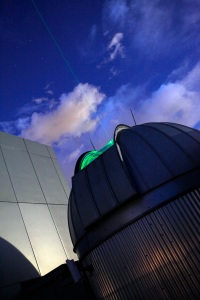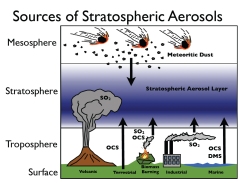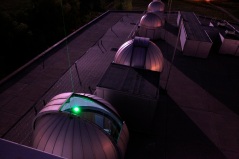Aerosols paint clearer warming slowdown picture
July 23, 2011 — andyextance

Light from a LIDAR instrument forms a beam in the sky over Boulder, Colo.. NOAA researchers and colleagues used LIDAR data to better understand recent changes in the amounts of tiny particles high in Earth's atmosphere.Credit: CIRES/NOAA
Increased amounts of tiny, airborne solid and liquid particles between 10 and 50 km above the Earth’s surface have slowed recent global warming, US scientists said Thursday. Such mixtures of particles in air, called aerosols, are already known to influence climate, including by reflecting energy from the sun back out into space. Now, Ellsworth Dutton and his colleagues from the US National Oceanic and Atmospheric Administration (NOAA) have identified previously overlooked aerosols, he told Simple Climate. “Additional aerosols that had not been previously known contributed to the planet being slightly cooler than it would have been without those aerosols over the past about a decade,” he said.
From 2002-2009, average global temperatures decreased – although, due to the short length of this period, this trend fails the key scientific test of “statistical significance”. This is despite increased amounts of the greenhouse gas CO2 being emitted by humans burning fossil fuels, which basic climate science predicts should warm the planet. Though Dutton and his colleagues were not seeking to resolve this contradiction, they were interested in how the composition of Earth’s atmosphere varies over periods of months to years. “Several sets of measurements were indicating some small but consistent changes that had not yet been analysed and evaluated,” Dutton said. “Then several of us got our information together to see what it might be telling us.”
Attacking the problem from space with lasers

Sources of aerosols reach the stratosphere from above and below, as shown in the graph. Sulfur dioxide (SO2), carbonyl sulfide (OCS), and dimethyl sulfide(DMS) are the dominant surface emissions which contribute to aerosol formation. Credit: NOAA
One key new data set came from Cloud-Aerosol LIDAR and Infrared Pathfinder Satellite Observations (CALIPSO), recorded since June 2006. CALIPSO’s LIDAR – Light Detection And Ranging – instrument provides information by shining a laser into the atmosphere, and detecting a “return signal” from light that scatters back to the satellite. “The strength and timing of that return signal to the spacecraft is indicative of the amount of aerosol present and at what height below the spacecraft,” Dutton explained. “With that and some information about the type of aerosol it might be, then estimates of the effects of the aerosols on sunlight can be made using some math and physics. We can most accurately estimate the contribution expected from aerosols once we know that they have been injected into the atmosphere and how many or how dense they are. Satellite measurements of aerosols are particularly helpful to determine where they came from and how widely they are being spread”
In combination with ground-based LIDAR, the CALIPSO measurements showed that the amount of aerosol in the stratosphere – the level of the atmosphere between about 10 and 50 km – surprisingly almost doubled from 2000 to 2010. “The background level of stratospheric aerosol contribution to potential climate change is different than previously known for the past decade,” Dutton said. During this period radiative forcing – a measure of the energy warming the planet – from CO2 added to the atmosphere was 0.28 W/m2. By comparison, in their paper published in top journal Science last week, the researchers found the cooling effect from stratospheric aerosols added over the same period was -0.10 W/m2.
What caused aerosol concentrations to increase is not completely known – although in recent weeks other US researchers suggested sulphur aerosols, largely from increases in coal burned in China, are largely responsible for recent cooling. However, there are also natural contributions, Dutton noted. “Some of the observations show quite definitively that many of the additional aerosols had come from relatively small volcanic eruptions to which other people had not paid much attention,” he said.
Moving background

LIDAR instruments - pointing up from the ground or down from satellites - use reflected light to measure the amounts of particles and their locations, which can influence climate. Credit: CIRES/NOAA
Though Dutton said that exactly how stratospheric aerosols have influenced climate change is difficult to determine, he and his colleagues did try to gain some understanding. Thanks to longer-term ground-based observations, particularly from Mauna Loa in Hawaii, where measurements have been taken since 1958, the NOAA scientists were also able to reconstruct the effects of stratospheric aerosols in the past. “By comparing the changes in that record to the more recent events we were able to infer earlier impacts from the longer record,” Dutton explained.
Models used to predict future climate change had previously included the influence of the kind of “background aerosols” represented in this reconstructed record. However, the NOAA scientists data showed previous models didn’t represent the actual impact stratospheric aerosols have had. “We found that the background amount had been varying in ways not previously accounted for,” Dutton said. Feeding their data into climate models suggested the increase in aerosols decreased the global warming that would have otherwise occurred since the late 1990s by 0.07°C. In 2000, global average surface temperatures according to NOAA’s own data were 0.40°C above the average for 1901-2000. In 2010, the average was 0.63°C.
“Climate model scenarios that neglect the changes in background stratospheric aerosols relative to the year 2000 should be expected to continue to overestimate radiative forcing changes and the related global warming in the coming decade if the stratospheric aerosol burden were to remain constant at current values or continue to increase,” the scientists wrote in Science. “On the other hand, if stratospheric aerosols were to decay back to their 1960 levels within the next decade, then the rate of warming would be faster, and the global average temperature is estimated to be 0.06°C greater by 2020.”
Comments (0)
You don't have permission to comment on this page.